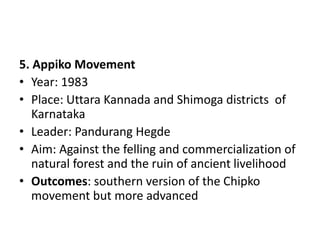Environmental movements in india
- 1. Environmental Movements in India By Md Nazeer Hussain D/O- Political Science, USTM
- 2. In India unrestricted exploitation of resources Mostly because of new consumerist lifestyles that disrupts the balance of nature Ultimately Various environmental movements existed in India
- 3.  What is an Environmental Movement? • social or political movement • conservation of environment • Synonymous with ‘green movement’ or ‘conservation movement’  Aims and objectives • sustainable management of natural resources • changes in public policy • centred on ecology, health and human rights  Range: from the highly organized to radically informal activities; from local to global
- 4. Major Environmental Movements in India 1. Bishnoi Movement • Year: 1700s • Place: Khejarli, Marwar region, Rajasthan state. • Leader: Amrita Devi • Aim: Save sacred trees from being cut down by the king’s soldiers to establish a new palace
- 5. Outcomes • Villagers along-with Amrita Devi hugged trees • 363 Bishnoi villagers were killed • Movement was based on Bishnoi faith taught by Guru Maharaj Jambaji not to harm trees and animals • When king came to know about these events, apologised and declared Bishnoi state protected area forbidding harm to trees and animals • legislation still exists in the region
- 6. 2. Chipko Movement • Year: 1973 • Place: Chamoli district and later Tehri-Garhwal district (Uttarakhand) • Leaders: Prominent were Sundarlal Bahuguna and Gaura Devi • Aim: The main objective was to protect the trees on the Himalayan slopes from the axes of contractors of the forest
- 7. Outcomes • Women started to hug the trees • Demanded that the benefits of forests should go to local people • 1978, women faced police firings and other tortures • Chief Minister, Hemwati Nandan Bahuguna set up a committee • Committee ruled in favour of the villagers
- 8. 3. Save Silent Valley Movement • Year: 1978 • Place: Silent Valley, Palakkad district of Kerala • Leaders: Kerala Sastra Sahitya Parishad (KSSP, an NGO), and the poet-activist Sughathakumari • Aim: protecting the Silent Valley from being destroyed by a hydroelectric project
- 9. Outcomes • Govt. of Indira Gandhi (1981) called off hydroelectric dam across the Kunthipuzha River that runs through Silent Valley • 1985, Prime Minister Rajiv Gandhi formally inaugurated the Silent Valley National Park
- 10. 4. Jungle Bachao Andholan • Year: 1982 • Place: Singhbhum district of Bihar • Leaders: The tribals of Singhbhum • Aim: Against governments decision to replace the natural sal forest withTeak • Outcome: later movement spread to Jharkhand and Orissa
- 11. 5. Appiko Movement • Year: 1983 • Place: Uttara Kannada and Shimoga districts of Karnataka • Leader: Pandurang Hegde • Aim: Against the felling and commercialization of natural forest and the ruin of ancient livelihood • Outcomes: southern version of the Chipko movement but more advanced
- 12. 6. Narmada Bachao Andholan (NBA) • Year: 1985 • Place: Narmada River, which flows through the states of Gujarat, Madhya Pradesh and Maharashtra • Leaders: Prominent, Medha Patker and Baba Amte • Aim: A social movement against a number of large dams being built across the Narmada River
- 13. Outcomes • Initially rehabilitation and resettlement because of the construction of Sardar Sarovar Dam • Later voice was raised for the preservation of environment and the eco-systems • demanded height of the dam from proposed 130m to 88m • World Bank withdrew from the project • Supreme Court judgement height upto 90m
- 14. 7. Tehri Dam Conflict • Year: 1990s • Place: Bhagirathi River near Tehri Uttarakhand • Leader: Sundarlal Bahuguna • Aim: The protest was against the displacement of town inhabitants and environmental consequence of the weak ecosystem Outcome: no popular support













